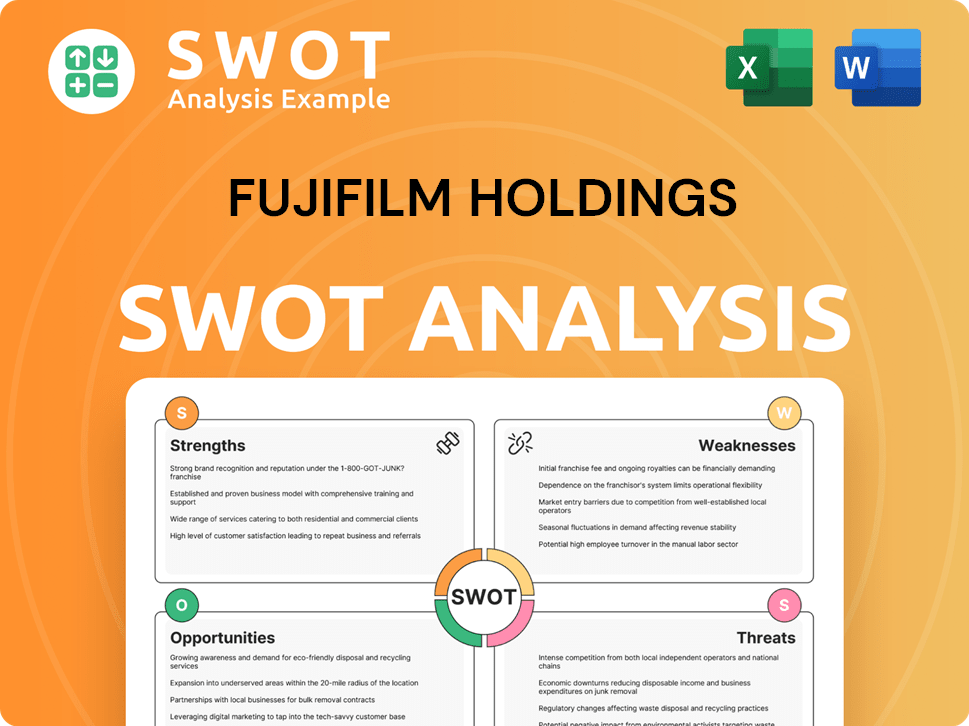Fujifilm Holdings Bundle
How Does Fujifilm Thrive in Today's Competitive Markets?
From its origins in photographic film, Fujifilm Holdings Company has masterfully transformed itself into a diversified powerhouse. This evolution showcases an impressive ability to adapt and innovate in response to market shifts. This analysis delves into the Fujifilm Holdings SWOT Analysis, exploring its strategic pivots and competitive positioning.

Understanding the Fujifilm competitive landscape is key to grasping its strategic success. This piece provides a deep dive into Fujifilm competitors, its market share, and the driving forces behind its industry analysis. We'll explore Fujifilm's business strategy, including recent acquisitions and partnerships, to understand its financial performance and future growth strategies in a rapidly evolving global market, including a competitive comparison with rivals like Canon and Sony.
Where Does Fujifilm Holdings’ Stand in the Current Market?
Fujifilm Holdings Corporation has established a strong market position through strategic diversification across its core business segments: Healthcare, Materials, and Imaging. This diversified approach allows Fujifilm to mitigate risks and capitalize on growth opportunities in various sectors. The company's ability to innovate and adapt to changing market dynamics is a key factor in its sustained success within the Fujifilm competitive landscape.
The company's value proposition centers on leveraging advanced technologies and expertise in imaging, materials science, and healthcare to deliver high-quality products and solutions. Fujifilm's focus on innovation and customer-centric approaches allows it to compete effectively in diverse markets. The company's commitment to research and development ensures a pipeline of new products and services, strengthening its competitive edge and market share.
Fujifilm's financial health remains robust, with reported revenues for the fiscal year ending March 31, 2024, at approximately JPY 2,900 billion (around USD 19.5 billion). This demonstrates its scale and stability compared to industry averages. Fujifilm's strategic investments and acquisitions, particularly in the healthcare sector, have been instrumental in expanding its market presence and driving revenue growth. An in-depth Fujifilm industry analysis reveals the company's resilience and adaptability.
Fujifilm holds a significant presence in medical imaging and informatics. It offers a wide range of products, including X-ray diagnostic imaging systems and endoscopy systems. The company is actively expanding its healthcare portfolio through strategic acquisitions and investments in pharmaceuticals and regenerative medicine. Fujifilm's advancements in endoscopy technology aid in early disease detection.
Fujifilm leverages its advanced chemical technologies to produce high-performance materials for displays, electronic materials, and industrial products. Its expertise in thin-film technology and functional materials provides a competitive edge in specialized markets. This segment contributes significantly to the company's overall revenue and market position.
The Imaging segment continues to evolve with a focus on professional and consumer photographic products, instant photography, and optical devices. Fujifilm maintains a strong brand reputation in the professional photography market. It has seen renewed success with its instant camera lines, expanding its market share in the consumer segment.
Fujifilm has a robust global presence with significant operations and sales in Asia, North America, and Europe. This diversified geographic footprint helps to mitigate risks and capitalize on international growth opportunities. The company's widespread presence is a key factor in its overall market strength.
Fujifilm's competitive advantages include its diversified business model, technological expertise, and strong brand reputation. However, it faces challenges such as the digital transformation of the imaging market and intense competition in its core segments. Understanding the Fujifilm competitors and their strategies is crucial for sustained growth.
- Competitive Landscape: Key competitors include Canon, Sony, and various companies in the medical imaging and materials science sectors.
- Market Share: Fujifilm maintains a significant Fujifilm market share in its core segments, particularly in medical imaging and instant photography.
- Business Strategy: Fujifilm's Fujifilm business strategy involves continuous innovation, strategic acquisitions, and geographic expansion to maintain and enhance its market position.
- Recent Acquisitions: Fujifilm has made several recent acquisitions to strengthen its healthcare portfolio and expand its capabilities in pharmaceuticals and regenerative medicine.
Fujifilm Holdings SWOT Analysis
- Complete SWOT Breakdown
- Fully Customizable
- Editable in Excel & Word
- Professional Formatting
- Investor-Ready Format

Who Are the Main Competitors Challenging Fujifilm Holdings?
The Fujifilm competitive landscape is complex, reflecting its diverse business segments. Fujifilm Holdings Company faces significant competition across healthcare, materials, and imaging sectors. Understanding its key rivals is crucial for assessing its market position and strategic direction. This analysis will examine the major players challenging Fujifilm in each of its core areas.
Fujifilm's ability to navigate this competitive environment is critical for its financial performance. Its business strategy involves continuous innovation, strategic partnerships, and acquisitions to maintain and grow its market share. Recent acquisitions and collaborations highlight Fujifilm's efforts to strengthen its position and adapt to changing market dynamics.
For a deeper dive into the company's origins and evolution, consider reading the Brief History of Fujifilm Holdings.
In medical imaging and informatics, Fujifilm competes with Siemens Healthineers, GE Healthcare, and Philips Healthcare. These companies offer comprehensive medical equipment, diagnostic systems, and IT solutions. Competition focuses on technological innovation, integration capabilities, and global service networks.
In the pharmaceutical and biopharmaceutical CDMO space, rivals include Lonza, Catalent, and Thermo Fisher Scientific's Patheon. These companies compete on manufacturing capacity, technological expertise, and regulatory compliance. Fujifilm has been expanding its presence in this area.
In the materials segment, Fujifilm faces competition from DuPont, BASF, and various Asian manufacturers. These competitors specialize in display materials, electronic materials, and industrial chemicals. They often have deep expertise in specific material science applications.
In digital cameras and optical devices, Fujifilm competes with Canon, Sony, and Nikon. In the printing and graphic arts industry, competitors include HP, Canon, and Ricoh. These companies offer commercial printing solutions and related services.
Emerging players, particularly in specialized healthcare technologies and advanced materials, challenge established companies. These new entrants often introduce niche innovations or disruptive business models. Strategic alliances and mergers shape the competitive landscape.
The competitive environment is dynamic, influenced by strategic alliances and mergers. Companies seek to consolidate market share and enhance technological capabilities. This ongoing evolution requires Fujifilm to continually adapt its strategies.
Fujifilm's competitive landscape is characterized by a mix of established and emerging players. The company's ability to innovate and adapt is crucial for maintaining its market share. The healthcare sector is highly competitive, with major players like Siemens Healthineers and GE Healthcare. The materials segment faces competition from specialized chemical companies like DuPont and BASF. In imaging and graphic arts, Canon, Sony, and Nikon are key rivals.
- Fujifilm market share is influenced by its ability to differentiate its products and services.
- Fujifilm industry analysis reveals a constant need for innovation and strategic partnerships.
- Fujifilm business strategy includes expanding into high-growth areas like biopharmaceuticals.
- Fujifilm's rivals in the camera market include Canon, Sony, and Nikon.
Fujifilm Holdings PESTLE Analysis
- Covers All 6 PESTLE Categories
- No Research Needed – Save Hours of Work
- Built by Experts, Trusted by Consultants
- Instant Download, Ready to Use
- 100% Editable, Fully Customizable

What Gives Fujifilm Holdings a Competitive Edge Over Its Rivals?
The competitive advantages of Fujifilm Holdings Company are rooted in its robust R&D, proprietary technologies, and strategic diversification. Initially known for photographic film, Fujifilm has successfully repurposed its imaging and chemical technologies across healthcare and materials science. These core competencies allow the company to develop cutting-edge products and solutions, maintaining a competitive edge in various sectors.
Fujifilm's brand equity, particularly in imaging, fosters customer loyalty and trust, extending into new segments. Its global distribution network and established sales channels further enhance market reach. In healthcare, Fujifilm's integrated approach, combining diagnostic imaging, medical informatics, and life sciences, differentiates it from specialized competitors. The company's adaptive culture and strategic partnerships support its ability to respond to market changes and pursue new opportunities.
Understanding the Growth Strategy of Fujifilm Holdings provides insights into its competitive positioning. Fujifilm's strategy involves continuous investment in R&D, focusing on innovation in key growth areas like healthcare and materials. This commitment to innovation allows Fujifilm to introduce advanced products and solutions, maintaining a competitive edge.
Fujifilm's substantial investment in research and development is a key competitive advantage. This includes expertise in thin-film coating, nanotechnology, and advanced materials science. The company's R&D spending in fiscal year 2024 was approximately ¥190 billion, demonstrating a commitment to innovation.
The Fujifilm brand is associated with quality and reliability, particularly in imaging. This strong brand equity allows Fujifilm to maintain customer loyalty and successfully extend into new segments. Fujifilm's brand recognition contributes to its competitive edge in the market.
Fujifilm's successful diversification strategy, moving beyond photographic film, has strengthened its competitive position. Its global distribution network and established sales channels support its market reach. This diversification has enabled Fujifilm to navigate market changes effectively.
In the healthcare sector, Fujifilm combines diagnostic imaging, medical informatics, and life sciences. This integrated approach differentiates it from competitors. The healthcare business accounted for a significant portion of Fujifilm's revenue in 2024, highlighting its importance.
Fujifilm's competitive advantages include strong R&D, brand equity, diversification, and an integrated approach to healthcare. These strengths enable Fujifilm to compete effectively in various markets.
- Advanced imaging and chemical technologies.
- Strong brand recognition and customer loyalty.
- Global distribution and sales channels.
- Integrated healthcare solutions.
Fujifilm Holdings Business Model Canvas
- Complete 9-Block Business Model Canvas
- Effortlessly Communicate Your Business Strategy
- Investor-Ready BMC Format
- 100% Editable and Customizable
- Clear and Structured Layout

What Industry Trends Are Reshaping Fujifilm Holdings’s Competitive Landscape?
The competitive landscape for Fujifilm Holdings Company is dynamic, shaped by industry trends, future challenges, and emerging opportunities. Understanding these factors is crucial for assessing Fujifilm's strategic positioning and future growth potential. The company operates in diverse sectors, including healthcare, materials, and imaging solutions, each facing unique pressures and prospects. Fujifilm's ability to navigate these complexities will determine its success in the coming years. A deep dive into the Fujifilm competitive landscape reveals a company adapting to shifts in technology and market demands.
Fujifilm's market share and overall financial performance are influenced by its ability to innovate and respond to market dynamics. The company’s business strategy involves strategic partnerships and investments in high-growth areas. This approach is essential for maintaining a competitive edge in a rapidly evolving global market. For more insights into Fujifilm's operations, consider exploring the Revenue Streams & Business Model of Fujifilm Holdings.
Technological advancements, especially in AI and digital transformation, are reshaping the healthcare and materials industries. The demand for personalized medicine and eco-friendly materials is increasing. Fujifilm is well-positioned to capitalize on these trends through its medical systems and materials science divisions. The company's focus on AI-powered diagnostic tools and sustainable materials aligns with these shifts.
Intense competition from tech giants and stringent regulatory requirements pose significant challenges, especially in healthcare. Volatile raw material prices and supply chain disruptions also create risks. Fujifilm must continuously invest in R&D and adapt to evolving market dynamics to maintain its competitive position. Increased regulation in healthcare and environmental sectors could also impact profitability.
Emerging markets, particularly in Asia, offer significant growth potential for healthcare infrastructure and advanced materials. Strategic partnerships and product innovation in high-growth areas like regenerative medicine and advanced materials are crucial. Leveraging its vast intellectual property portfolio will also be key for Fujifilm to maintain its competitive edge. The company's diversified strategy positions it to navigate these challenges and capitalize on opportunities.
Fujifilm is focusing on high-value-added solutions and sustainable growth. This includes investments in AI, biotechnology, and eco-friendly materials. The company is also expanding its presence in emerging markets and forming strategic partnerships to enhance its competitive position. Recent acquisitions and R&D efforts demonstrate Fujifilm's commitment to innovation.
Fujifilm faces a complex competitive landscape, driven by industry trends, challenges, and opportunities. The company’s strategic initiatives, including investments in AI and sustainable materials, are critical for future growth. Fujifilm's ability to adapt to market changes and leverage its strengths will determine its long-term success. Fujifilm's competitive advantages include a diversified portfolio and strong R&D capabilities.
- Market Analysis 2024: Fujifilm's financial performance in 2024 will be influenced by its ability to navigate global economic shifts and geopolitical tensions.
- Competitive Comparison: Fujifilm's rivals in the camera market include Sony and Canon, with Fujifilm focusing on innovation in areas like mirrorless cameras.
- Strategic Partnerships: Fujifilm Holdings Company strategic partnerships are vital for expanding its market reach and developing new technologies.
- Healthcare Industry: Fujifilm's position in the healthcare industry is strengthened by its focus on medical imaging and pharmaceuticals, with significant growth potential in emerging markets.
Fujifilm Holdings Porter's Five Forces Analysis
- Covers All 5 Competitive Forces in Detail
- Structured for Consultants, Students, and Founders
- 100% Editable in Microsoft Word & Excel
- Instant Digital Download – Use Immediately
- Compatible with Mac & PC – Fully Unlocked

Related Blogs
- What are Mission Vision & Core Values of Fujifilm Holdings Company?
- What is Growth Strategy and Future Prospects of Fujifilm Holdings Company?
- How Does Fujifilm Holdings Company Work?
- What is Sales and Marketing Strategy of Fujifilm Holdings Company?
- What is Brief History of Fujifilm Holdings Company?
- Who Owns Fujifilm Holdings Company?
- What is Customer Demographics and Target Market of Fujifilm Holdings Company?
Disclaimer
All information, articles, and product details provided on this website are for general informational and educational purposes only. We do not claim any ownership over, nor do we intend to infringe upon, any trademarks, copyrights, logos, brand names, or other intellectual property mentioned or depicted on this site. Such intellectual property remains the property of its respective owners, and any references here are made solely for identification or informational purposes, without implying any affiliation, endorsement, or partnership.
We make no representations or warranties, express or implied, regarding the accuracy, completeness, or suitability of any content or products presented. Nothing on this website should be construed as legal, tax, investment, financial, medical, or other professional advice. In addition, no part of this site—including articles or product references—constitutes a solicitation, recommendation, endorsement, advertisement, or offer to buy or sell any securities, franchises, or other financial instruments, particularly in jurisdictions where such activity would be unlawful.
All content is of a general nature and may not address the specific circumstances of any individual or entity. It is not a substitute for professional advice or services. Any actions you take based on the information provided here are strictly at your own risk. You accept full responsibility for any decisions or outcomes arising from your use of this website and agree to release us from any liability in connection with your use of, or reliance upon, the content or products found herein.